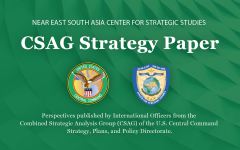Impact of India-China Tensions in the CENTCOM AoR
January 25, 2021 2021-01-25 16:03Impact of India-China Tensions in the CENTCOM AoR
By Lt Col Farhan Ali, Pakistan Army, US Central Command: Strategy Plans and Policy Directorate; Combined Strategic Analysis Group
25 Jan 2021
Introduction:
Complex territorial disputes, economic competition, and broader geostrategic competition between India and China cause tensions along the world’s longest unsettled group of borders. The circa 3500 kilometer Indo-China border is divided into Western, Middle, and Eastern Sectors. The Western Sector lies between Indian Occupied Kashmir and Xingjian, where India accuses China of illegal occupation. The Middle Sector (the least controversial of the three) Indian states of Himachal, Pradesh, and Uttarakhand share boundaries with China. The Eastern Sector is defined by the McMahon Line which separates the Chinese Tibet Region from Arunachal Pradesh, though China claims the whole area. Both countries have held twenty sessions over three decades to sort out their inconclusive border issues. On May 5th – 6th 2020, Indian and Chinese troops clashed in Hot Spring, Pangong Lake (Galwan Valley, Western Sector) while on May 10th 2020, troops clashed in the Eastern Sector’s Naku La area. Such conflicts regularly take place during summers when melted snow offers greater mobility to patrolling troops from both sides. Each country’s troops assert their presence through aggressive posturing and sometimes verbal altercations. However, three distinct features indicate this current standoff is different: the scale of forces and reinforcements involved; the kinetic fight amongst troops; and the Chinese ingress into Galwan Valley, far beyond its own claimed line.
Key Points:
- Indian unilateralism in border disputes with China, Pakistan, and Nepal has not only drainedeconomic, military, and diplomatic resources, but has also caused destabilization and harmed regional development.
- India recently increased regional tensions by asserting claims to territory currently recognized by the UN as belonging to, and occupied by, China, Pakistan, and Nepal.
- In response to India’s assertions, Pakistan launched diplomatic and media protests, the Nepalese parliament declared its own territorial counterclaims, and China forcibly occupied Indian-claimed lands, in the process engaging in border skirmishes with Indian troops.
- Should India persist, the crises will likely aggravate tensions and cause more skirmishes.
- Since India appears unlikely to counter China’s moves militarily, India may jeopardize its stature as a regional leader and perceived counterweight against China.
- Growing Indian multilateral defense cooperation will likely embolden India, intensify the regional arms race, increase instability in this already volatile region, and incentivize unconventional conflict.
- The current military standoff highlights the need for strategic restraint by regional giants, and sincere international community efforts to prevent escalation.
The opinions and conclusions expressed herein are those of a number of international officers within the Combined Strategic Analysis Group (CSAG) and do not necessarily reflect the views of United States Central Command, not of the nations represented within the CSAG or any other governmental agency.






